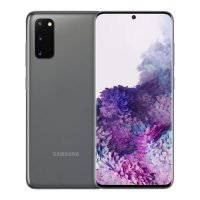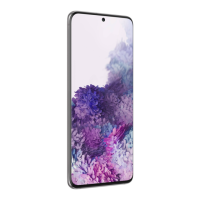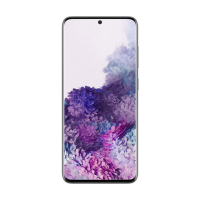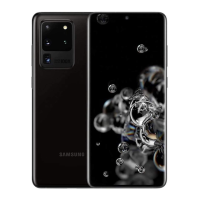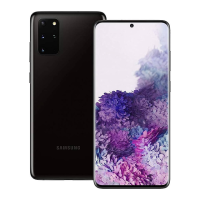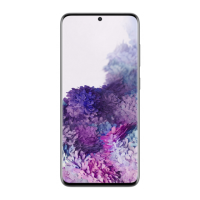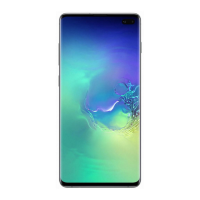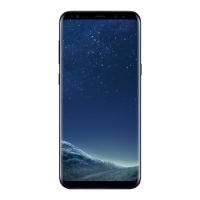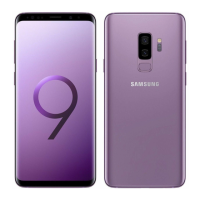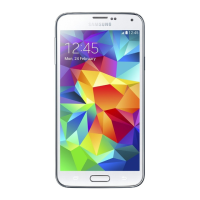Do you have a question about the Samsung SM-G980F and is the answer not in the manual?
Important safety and usage guidelines before operating the device.
Identifies physical parts and buttons of the device for easy reference.
Lists included items and explains device buttons and screen controls.
Guides on charging, battery tips, power saving, and wireless charging features.
Instructions on how to charge the device battery safely and efficiently.
Guides on inserting SIM/USIM and microSD cards into the device.
Guides the user through the initial device setup process after first use or reset.
Explains how to create, sign in, and manage your Samsung account.
Instructions for migrating data from an old device using Smart Switch or USB.
Covers touch gestures, navigation bar, and basic screen operation.
Guides on downloading, installing, managing, and setting app permissions.
Covers making calls, managing contacts, and blocking numbers.
Step-by-step guide on initiating calls and managing the contact list.
Covers sending messages and browsing the internet.
Comprehensive guide to using the camera for photos, videos, and various shooting modes.
How to capture photos, record videos, and use shooting modes like Pro and Food.
Viewing, editing, and organizing photos and videos.
Using split screen, pop-up views, and Edge panels for multitasking and quick access.
Setting up and making payments using Samsung Pay.
Using Samsung Health for wellness, fitness goals, and step tracking.
Using Samsung Notes, Calendar for scheduling, and Voice Recorder for memos.
Using clock features like alarms and managing files with My Files.
Optimizing the gaming experience with performance modes and boosters.
Using the smartphone as a desktop computer with external displays.
Configuring Wi-Fi, Bluetooth, mobile networks, NFC, and data usage.
Steps to connect to Wi-Fi networks and pair Bluetooth devices.
Customizing sound modes, ringtones, notification sounds, and vibration.
Adjusting brightness, blue light filter, dark mode, screen resolution, and font.
Reducing eye strain and optimizing screen appearance in different lighting.
Options for screen lock types, biometrics, and secure folder.
Registering and using face and fingerprint for device security.
Syncing, backing up, and restoring data using Samsung Cloud and Smart Switch.
Enabling and customizing advanced device features like Bixby Routines and Motions.
Checking device status, optimizing performance, and managing battery and storage.
Selecting power modes and managing battery usage for extended life.
Customizing system settings and improving device usability.
Configuring settings to improve device usability for all users.
Solutions for common device problems like codes, network errors, and power issues.
Troubleshooting tips for slow or unresponsive touchscreen performance.
RF exposure, SAR information, and FCC compliance details for user safety.
Regulations and ratings for wireless device compatibility with hearing aids.
Important safety and usage guidelines before operating the device.
Identifies physical parts and buttons of the device for easy reference.
Lists included items and explains device buttons and screen controls.
Guides on charging, battery tips, power saving, and wireless charging features.
Instructions on how to charge the device battery safely and efficiently.
Guides on inserting SIM/USIM and microSD cards into the device.
Guides the user through the initial device setup process after first use or reset.
Explains how to create, sign in, and manage your Samsung account.
Instructions for migrating data from an old device using Smart Switch or USB.
Covers touch gestures, navigation bar, and basic screen operation.
Guides on downloading, installing, managing, and setting app permissions.
Covers making calls, managing contacts, and blocking numbers.
Step-by-step guide on initiating calls and managing the contact list.
Covers sending messages and browsing the internet.
Comprehensive guide to using the camera for photos, videos, and various shooting modes.
How to capture photos, record videos, and use shooting modes like Pro and Food.
Viewing, editing, and organizing photos and videos.
Using split screen, pop-up views, and Edge panels for multitasking and quick access.
Setting up and making payments using Samsung Pay.
Using Samsung Health for wellness, fitness goals, and step tracking.
Using Samsung Notes, Calendar for scheduling, and Voice Recorder for memos.
Using clock features like alarms and managing files with My Files.
Optimizing the gaming experience with performance modes and boosters.
Using the smartphone as a desktop computer with external displays.
Configuring Wi-Fi, Bluetooth, mobile networks, NFC, and data usage.
Steps to connect to Wi-Fi networks and pair Bluetooth devices.
Customizing sound modes, ringtones, notification sounds, and vibration.
Adjusting brightness, blue light filter, dark mode, screen resolution, and font.
Reducing eye strain and optimizing screen appearance in different lighting.
Options for screen lock types, biometrics, and secure folder.
Registering and using face and fingerprint for device security.
Syncing, backing up, and restoring data using Samsung Cloud and Smart Switch.
Enabling and customizing advanced device features like Bixby Routines and Motions.
Checking device status, optimizing performance, and managing battery and storage.
Selecting power modes and managing battery usage for extended life.
Customizing system settings and improving device usability.
Configuring settings to improve device usability for all users.
Solutions for common device problems like codes, network errors, and power issues.
Troubleshooting tips for slow or unresponsive touchscreen performance.
RF exposure, SAR information, and FCC compliance details for user safety.
Regulations and ratings for wireless device compatibility with hearing aids.
| Model | SM-G980F |
|---|---|
| Display | 6.2 inches |
| Resolution | 1440 x 3200 pixels |
| Processor | Exynos 990 (7 nm+) |
| RAM | 8GB |
| Storage | 128GB |
| Front Camera | 10 MP |
| Battery | 4000 mAh |
| Dimensions | 151.7 x 69.1 x 7.9 mm |
| Weight | 163 g |
| Network Technology | GSM / CDMA / HSPA / EVDO / LTE |
| Announced | 2020, February 11 |
| Build | Glass front (Gorilla Glass 6), glass back (Gorilla Glass 6), aluminum frame |
| SIM | Single SIM (Nano-SIM) or Hybrid Dual SIM (Nano-SIM, dual stand-by) |
| Display Type | Dynamic AMOLED 2X, 120Hz, HDR10+ |
| Protection | Corning Gorilla Glass 6 |
| Chipset | Exynos 990 (7 nm+) |
| CPU | Octa-core (2x2.73 GHz Mongoose M5 & 2x2.50 GHz Cortex-A76 & 4x2.0 GHz Cortex-A55) |
| GPU | Mali-G77 MP11 |
| Loudspeaker | Yes, with stereo speakers |
| 3.5mm jack | No |
| WLAN | Wi-Fi 802.11 a/b/g/n/ac/6, dual-band, Wi-Fi Direct, hotspot |
| Bluetooth | 5.0, A2DP, LE |
| NFC | Yes |
| USB | USB Type-C 3.2, USB On-The-Go |
| Sensors | Fingerprint (under display, ultrasonic), accelerometer, gyro, proximity, compass, barometer |
| Charging | 25W wired, 15W wireless, 4.5W reverse wireless |
| Water Resistance | IP68 dust/water resistant (up to 1.5m for 30 mins) |
| 5G Support | No |
| Rear Camera | 12 MP (wide), 12 MP (ultrawide), 64 MP (telephoto) |
| Operating System | Android 10, upgradable to Android 13 |
| Status | Available. Released 2020, March 06 |
| Radio | FM radio |
